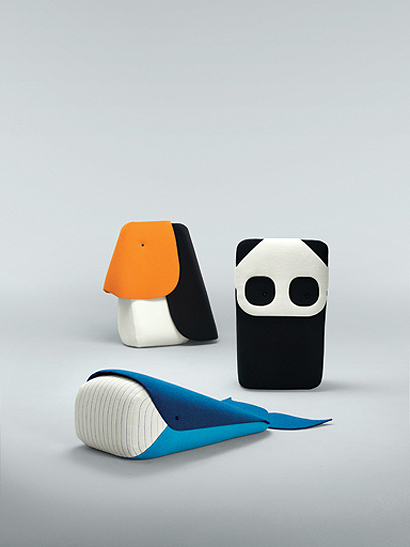|
|
||
|
Stuffed animals, a hammock, a dip-dyed sofa and moccasins were among the colourful contributions to Kvadrat’s exhibition at the Jil Sander showroom during Milan Design Week. The show of 32 international projects was a celebration of the Danish company’s ultra-durable textile Hallingdal 65. The wool-and-viscose fabric has been in production for 47 years and is associated with iconic designs such as Arne Jacobsen’s Swan and Egg chairs. The eclectic pieces, by designers both established and upcoming, were chosen by seven regional curators: Tord Boontje for the UK, Ilse Crawford for the Netherlands and Belgium, Constance Rubini for Southern Europe, Søren Rose for Scandinavia, Hans Maier-Aichen for Germany, Jeffrey Bernett for the US and Andre Fu for Asia. The curators’ only instructions were to commission projects that interpret the fabric in a contemporary way.
Danish designer Søren Rose, who selected six projects for the show, says: “The UK has its history, the French their poetry, the Italians their art, the Danish their craftsmanship and so on. [The resulting pieces] are a complete mix of different principles and styles.” Some designers chose to give traditional upholstery a new twist. For Framed, Mischer Traxler clamped sheets of fabric to a series of wooden benches, making explicit the connection between furniture and covering. Philippe Malouin treated the fabric on his Hardie Stools with hardening resin to make the Hallingdal a structural element as well as aesthetic. Others, like New York-based Todd Bracher and Swedish trio Front, deconstructed the fabric altogether. Bracher’s reductive Hadr chair consisted of individual coloured threads woven on to a frame. Front boiled the fabric until it felted, making patchwork rugs with fringed edges. “The funny thing about this process is that nobody from Denmark had the guts to take this textile apart and really screw it up,” says Rose. “We grew up with it and have this sense of respect. The Front girls had another approach, but they too found an interesting aspect to what the fabric can achieve.”
In tribute to Hallingdal’s original creators, the Danish graphic artist Hjortefar made two enormous portraits of designer Nanna Ditzel and entrepreneur Percy Halling-Koch. Each was created with 3,600 square upholstered pads, measuring 5cm by 5cm each. To complete the project in time for Milan, Hjortefar enlisted the help of inmates at a Danish state prison to make the individual pads. “To be frank, we didn’t think it was going to happen,” says Rose. “But it’s there to remind us of the great beginnings of this fabric. Halling-Koch was the original branding guy, the marketeer. He was the one who went out and really sold it to the world.”
The rainbow colour spectrum of Hallingdal 65 gave the show an exuberance that was missing elsewhere in a quiet year for Milan. At first glance the installation looked like a sophisticated soft play area – a scattering of colourful fabric forms in the vast gallery space. Studio Glithero’s Tim Simpson says that the project to unite these diverse designers around a common material was a worthwhile one. “We were unsure at first. We thought this was going to be some kind of Eurovision Song Contest for design,” he says. “But it’s been really interesting to see how all these people have approached using the same material for different means.”
|
Image Angela Moore
Words Riya Patel |
|
|
||























